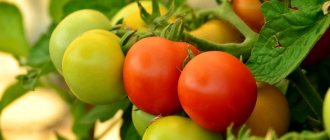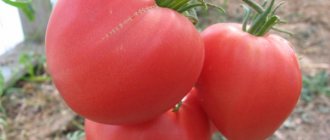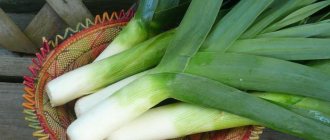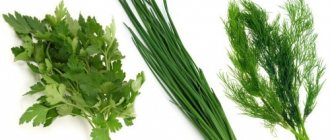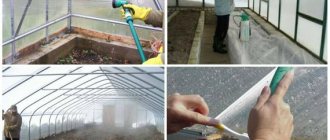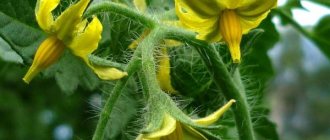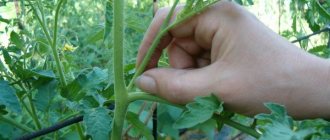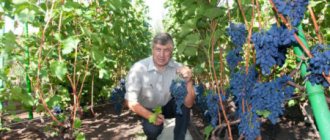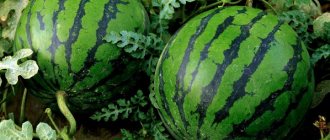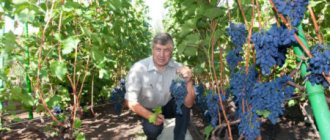In the last couple of decades, in summer cottages you can often see such a previously exotic vegetable as the cherry tomato (from the English Cherry - cherry). They began to cultivate it relatively recently, a little less than half a century, but during this time this variety of tomatoes has found well-deserved popularity not only as an edible plant, but also as an ornamental plant. There are a number of explanations for this. Firstly, they bloom very beautifully. Secondly, due to their different sizes, bushes - from half a meter to almost three - can create a unique look not only on the site, but also in the apartment and on the balcony. Thirdly, a variety of shapes and colors. Round, oval, cream, pear-shaped; red, orange, yellow, green, purple and even almost black. This whole range of colors simply cannot but please the eye of even a sophisticated gardener.
Tomatoes are widely in demand in cooking. They are used in the preparation of salads, appetizers, first and second courses, and go well with meat and fish, even when preparing barbecue. Cherries are perfect for decorating various delicacies and give the housewife the opportunity to experiment with creating her own masterpieces. Tomatoes look great when canned, being in no way inferior to their larger counterparts in taste. Since these tomatoes are very heat-loving, their cultivation, especially in areas with a cool climate, was quite difficult, since they could not ripen. But there is always a way out, and these are cherry tomatoes in a greenhouse. The method of growing them is not much different from the usual varieties, but still some rules should be followed.
Types and varieties of cherry
First of all, you need to decide on the tomato variety. This largely depends on the size of the greenhouse, as height plays an important role.
Determinant
Plants that stop growing depending on the number of tassels that have formed. As a rule, growth stops at 4-5 hands, less often - 7. These include:
- Ampelous. Maximum height 1 meter. Tomatoes are small in size, weighing approximately 15 g.
- Raisin F1. This is a hybrid whose fruits are in the form of cream. It differs from the previous one in earlier ripening, weight up to 20 g, and the number of ovaries - max. 20 and brushes – 7.
Determinate varieties are best suited for cultivation in greenhouses because they do not require pinching and are relatively small in size, forming into a powerful bush.
Interdeterminate
This type of tomato has almost unlimited growth, sometimes reaching 2.5-3 m. Such plants require careful pinching so that only the main stem remains on which the clusters are formed. They are also suitable for growing in open ground, but only in warm climates. In “mainstream” greenhouses (heating, lighting, etc.) they can bear fruit for more than a year.
- Pear yellow F1. A mid-season variety, the height of which fluctuates on average at around 2 m. The fruits are sweet and have a berry aftertaste.
- Date orange F1. Mid-season; The fruit is oval with a plum and honey flavor. The pulp has a characteristic amber color. The cluster contains up to 18 fruits with a maximum weight of 20 g.
- Black cherry F1. The name itself speaks about its color. Early ripening (65 days). The weight of the fruits ranges from 15-30 g, of which 10-12 pieces are formed per cluster.
Superdeterminant
They differ from determinant ones by their short stature and early maturity.
- Arctic. Very early variety (75-80 days). There are often up to 22 tomatoes on a bunch. Height no more than 40 cm.
- Citizen F1. Mid-season (up to 100 days from germination). The weight of these cherries is 15-25 g, of which there can be from 12 to 18 pieces. Ripening can be accelerated, but this requires pinching.
But that is not all. There are so-called semi-determinate tomatoes. They occupy an intermediate place between determinant and superdeterminant, both in height and in terms of ripening. These species are ideal for greenhouse conditions.
Harvest and storage times
The fruits in the garden are harvested 80–90 days after the seedlings emerge. In a greenhouse this happens 20–30 days earlier. You should not pick tomatoes unripe and leave them to ripen at home, because the taste of the fruit will deteriorate significantly. Only well-ripened tomatoes can be harvested. Fruiting in open ground lasts until the air temperature drops to 8°C. With such cold weather, tomatoes rot and fall off.
Cherry tomatoes are a wonderful variety that is suitable even for a novice gardener. Follow all the recommendations for growing them, and they will reward you with a good harvest.
Seed preparation
Before planting seedlings, seeds undergo preplanting treatment. Of course, you can sow dry, but then you may encounter: a) worse germination; b) slower growth; c) less resistance to diseases. But this applies only to varietal seeds. Hybrids do not require processing.
- The first step is poisoning. A 1% solution of potassium permanganate is prepared. To do this, 1 g of potassium permanganate is dissolved in 100 ml of water. The color should be almost black. The seeds should not be stuck together in any way. If this is observed, then they should be rubbed well to separate them from each other. After which they are wrapped in a bandage, gauze, placed in a bag and in this form are sent to a container for 20-45 minutes. After this procedure, the seed must be thoroughly rinsed in warm water and move on.
- Second step. The seeds are placed in a special nutrient solution without preliminary drying for 12 hours. For this, special growth stimulants for tomatoes are best suited, but you can get by with most liquid ones. It is important to study the instructions so as not to make a mistake in the proportions, since it is unlikely that anyone will prepare 1 liter for a handful of seeds.
- Third step. Without any rinsing, the bag is placed in water for a day, and then in the refrigerator for the same time, while periodic spraying is necessary.
After these procedures, the seeds are ready for planting.
For the Urals
Cherry tomatoes, according to the description of the best varieties, are not always suitable for growing in greenhouses in the Urals. Summer in the region is short and the temperature is unpredictable, so you should select tomatoes especially carefully.
Pink raisins
Small-fruited, persistent tomato with fan-shaped, large trusses. The tomatoes look like small pink plums, collected in abundant clusters of 40–50 pieces.
Characteristic
The Pink Raisin bush has a determinate type of development, the stems stop growing at a height of 1.5 m. The shoots of the plant are powerful, thick, and the foliage is moderate.
Pink raisins are classified as cocktail tomatoes. Their weight ranges from 30 to 50 g. The color is the same pink outside and inside. The pulp is juicy, sweet with moderate sourness.
Features of planting and care
Pink raisins are especially resistant to temperature changes and are easy to grow in the changing conditions of the Ural summer. The culture requires garter, moderate watering, and timely fertilizing.
Gold bead F1
Tall, ultra-early hybrid with amazingly beautiful clusters of aligned amber tomatoes. The weight of each fruit is no more than 15 g, but the number of ovaries can exceed 30 pieces. for one bunch.
Characteristic
The height of the Golden Bead bushes is more than 1.7 m. Garlands of fruits begin to ripen en masse after 80 days.
Pinkish-yellow tomatoes have a dense texture and a harmonious sweet taste with fruity notes. Productivity can exceed 6 kg per 1 sq. m.
Features of planting and care
For 1 sq. m place up to 4 tomatoes. The Golden Bead bush is led into 2 stems, the tops and stepsons are pinched. Maximum yield is achieved by applying fertilizing every 10–15 days.
Verige f1
An early-ripening, low-growing hybrid with red, round cherry tomatoes. Fruit weight is about 20 g. Each Verige cluster bears up to 12 tomatoes.
Characteristic
The compact Verige bush rarely exceeds 60 cm. Fruit ripening is simultaneous and early, occurring from 88 to 90 days from germination.
The yield is enviable for dwarf varieties - more than 1.5 kg per bush. The productivity of the variety for greenhouses exceeds 5 kg per 1 sq. m.
Features of planting and care
Despite their small growth, Verige tomatoes require gartering of stems. For 1 sq. m you can plant more than 4 bushes. According to reviews from gardeners, plants tolerate thickening up to 6 pcs. The hybrid variety perfectly resists infections and does not require additional treatments.
Planting seedlings
The time for planting seedlings varies from February to April, although practice shows that in hot climates it can also be grown without seedlings in greenhouses. The fruits ripen completely. It is best to take a ready-made store-bought substrate for seedlings. It has optimal nutrient content. If there is none, you need to prepare it yourself, paying attention to the type and acidity of the soil. It is advisable to heat it to protect the seedlings from root-gnawing pests. Soil is poured into the prepared containers. The grooves are made at a distance of 6-7 cm from each other, and between the seeds - 2-2.5 cm. The depth is just over a centimeter. Next, the soil is moistened and placed in a warm, well-lit place and covered with film or glass. It is important to place the container on a stand to allow air access to the roots. When seedlings appear, a temperature of +15-18 degrees is required for 7 days. Subsequently, it is raised to 20. Every day, the plants must be turned with the other side towards the light: this way one-sidedness can be avoided. Watering is done only twice until 2-3 true leaves appear. After their appearance, a pick is made. Weak sprouts are thrown away, and strong ones are best replanted in peat cups, so adaptation will occur better.
Tips and tricks for growing
Tomato bushes are heat-loving. If there is a danger of frost, cherry tomatoes are wrapped in paper or film materials overnight, and in some cases portable shelters are installed.
It is not recommended to plant seedlings on a hot day. It will be more difficult for the plant to take root, and the likelihood of drying out increases. It is preferable to plant seedlings on a cloudy day or in the evening when the heat subsides.
Water tomatoes strictly at the root. The presence of brown cracks may indicate a lack of moisture. If there is too much moisture, the fruits become watery and crack.
Planting in a greenhouse
An important factor in a good harvest is the location of the greenhouse itself. Tomatoes are sun-loving plants, so shading can have a negative impact on them. Planting ready-made seedlings depends not only on soil temperature and climatic conditions, but also on the variety and the desire of the gardener to obtain a harvest for as long as possible. The soil temperature should not be lower than +15°C. If desired, it is measured with an ordinary household thermometer, leaving it in the soil for 20 minutes. (It is best to take measurements early in the morning, since the ground is coldest at this time). During planting, the two lower leaves are removed and the plant is buried to this level. Watering is carried out no earlier than 12-14 days after planting. Planting scheme for low-growing plants: 40 cm between bushes and 45 cm between rows. For tall people: 50 and 75 cm, respectively. For convenience during further processing, it is recommended to plant tomatoes in a checkerboard pattern.
Features of cultivation
Before planting tomato seedlings, the greenhouse must be properly prepared. The soil needs to be changed annually. Planting cherry tomatoes in the same soil for several years in a row is unacceptable - this will significantly reduce the quality and yield of tomatoes.
Depending on the type of soil, fertilizers are also required. If clay predominates in the soil, then it is necessary to add peat or humus to it. If the soil is peaty, then sand should be added to it and fertilized with humus or sawdust.
It should be remembered that tomatoes, like no other plant, love warmth and light. Therefore, the greenhouse should be located in an open sunny place where the sun would be for the maximum amount of time.
After the soil is prepared, the seedlings can be planted. To do this, holes are dug in a checkerboard pattern. The distance between them should be at least half a meter. If the distance between plants is greater or less, this can significantly affect the volume of the harvest. It is worth remembering that in the first two weeks after planting seedlings in the greenhouse, there is no watering at all.
After 12 days you can start tying up the plant. Count the flower clusters - there should be no more than 8. In order for tomato flowers to be pollinated, they must be shaken. To carry out this procedure, it is better to choose a sunny, warm day, and after it is completed, the tomatoes should be sprinkled with water and poured under the bush.
The humidity level in a greenhouse is an indicator that should always be kept under control. In order to reduce it, turn on the ventilation system two hours after watering. If the humidity is too high, the taste of future tomatoes will not be of high quality - they will be watery and tasteless.
Tomatoes grow quite quickly in a greenhouse. From planting the seeds to the appearance of the first fruits, no more than three months pass. Cherry tomato fruits are very healthy and tasty. They will decorate any table. They can be eaten either independently or as part of a variety of dishes. Plants and their fruits need to be properly cared for: specialized stores offer many products that will help fight possible diseases and pests.
To prevent such problems from spreading too quickly in the greenhouse, be sure to maintain a certain distance between the holes when planting. High-quality and timely care will help you grow an enviable and tasty harvest in greenhouse conditions, which will be in no way inferior to tomatoes grown in open ground.
Tomato care
Cherry tomatoes for growing in a greenhouse do not require much trouble. Caring for them includes the standard “set”: watering, loosening, and for interdominant varieties, also pinching. Watering is necessary regularly, but not abundantly. A lack of moisture leads to cracking of the fruit, and an excess affects the wateriness and taste. Loosening improves air access to the roots and prevents them from rotting. Like ground tomatoes, those growing in a greenhouse are very sensitive to “rain” watering from a hose. Moreover, if this comes from a centralized water supply or a well. Cold water and high air temperatures have a detrimental effect on the bushes. The best option is to water the roots with warm water, for example from a barrel, which it is advisable to place directly in the greenhouse. Unlike other types of tomatoes, cherry tomatoes need to be tied up regardless of their size. This does not apply only to hanging varieties that are grown in a suspended state.
If in open areas the pollination process is carried out “naturally,” then in a greenhouse it is a human affair. There is nothing complicated: the brushes are slightly shaken. This causes pollen to spread to other flowers. It should be taken into account that the temperature should not be higher than +35 degrees and not lower than +12, the humidity should be no higher than 65%, and watering should be done after this operation no earlier than 2 hours later. The pollination procedure is carried out 2 times a week. Cherry tomatoes are fed in the same way as ordinary tomatoes. It’s difficult to do without chemicals, but manure was and is the best fertilizer. The solution is prepared as follows: manure is poured into the selected container and filled with water in a ratio of 1:10, mixed and left to ripen for 2-3 days, although the minimum is 1 day. Then dilute 1 liter in a bucket of water and add one liter at a time to the root.
Plant nutrition
Do not get carried away with fertilizing only with mineral fertilizers. For normal ovary formation and fruiting, nitrogen and phosphorus fertilizers are required .
A couple of weeks after planting, fertilize with urea, maintaining the proportions, one tablespoon per bucket of water. Water a liter of solution at the root of the plant . A solution of chicken manure and water, prepared in a ratio of 1:15, is suitable for fertilizing with nitrogen fertilizers.
Repeated stirring of the mixture is necessary . After a couple of days, water, preparing a solution at the rate of half a liter of mixture per bucket of water. Water one liter of mixture per plant. After 30-40 minutes, pour water under the root of the bush.
Cherry tomato diseases
Although these tomatoes are disease resistant, some varieties can develop fungi and rot. There may be late blight, bacteriosis, black leg, mosaic, root and apical rot, fruit cracking and others. Therefore, preventive and therapeutic measures are carried out, as for ordinary tomatoes.
Growing cherry tomatoes in a greenhouse is not difficult. The main thing is to adhere to agricultural technology, and then harvesting will bring complete satisfaction.
Use of grown tomatoes
Sweet taste, variety of colors, low calorie content have ensured great demand for cherry tomatoes in cooking. The size of the vegetable makes it indispensable in the decoration of the holiday table. Canned fruits are used in many recipes, including expensive and gourmet dishes.
Advice. Convenience during preservation is achieved by the assorted principle: large and miniature tomatoes are placed in jars at the same time. This ensures that the container is filled as much as possible.
Advantages and disadvantages
Cherry tomatoes (the best varieties for greenhouses have both strengths and weaknesses) should be chosen for your own greenhouse not only on the official description, but also on reviews from experienced vegetable growers. Based on reports on cultivation in personal farms and industrial greenhouses in different regions, conclusions can be drawn about the ideal Cherry for your own plot.
The article discusses the best varieties of cherry tomatoes for greenhouses.
| Variety | pros | Minuses |
| Sweet Cherry |
|
|
| Honey candy |
|
|
| Bakhchisarai |
|
|
| Blossam |
|
|
| Black cherry |
|
|
| Lykopa |
|
|
| Mio |
|
|
| Lisa Cherry |
|
|
| Pink raisins |
|
|
| gold bead |
|
|
| Verige |
|
|
| Necklace |
|
|
| Siberian cherry |
|
|
| Atom |
|
|
Cherry tomatoes are the most versatile group of tomatoes today. The best varieties for greenhouses are capable of producing high yields and developing well throughout Russia. Versatility also lies in the use of cherry harvest. Small, pretty tomatoes are not only put into salads, but also processed, dried, dried, and stored for the winter.
